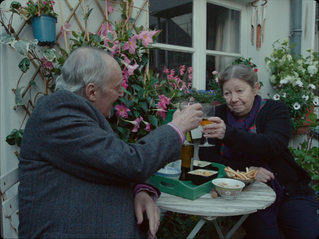Passive objects in Sofia Coppola’s On the Rocks
- Emma Olsson
- Dec 1, 2020
- 3 min read

What forms the trappings of modern status? Is it a lofty apartment in Manhattan’s Greenwich Village? Signing a book deal before writing the book? Experiencing domesticity as a symptom supplanting one’s agency, selfhood?
In On the Rocks, Sofia Coppola’s latest feature, Laura (Rashida Jones) is a modern mother who has just greeted an unwanted and age-old guest: infidelity. Suspicious of her husband, Dean (Marlon Wayans), Laura is swept off her feet by her father, Felix (Bill Murray), who plans to uncover Dean’s alleged affair with an attractive colleague. The father-daughter duo embarks on a mission of marriage espionage that disrupts Laura’s home life and identity, threatening to annihilate them.
Their journey is a delightful whistle-stop tour through Manhattan after dark: vintage open-top cars, crackers and caviar, belly-busting banana splits and bars with round, leather couches where faces are engulfed in a soft candlelight. It is the New York City of a lost era and Felix – bon vivant, unabashed womaniser – squeezes out every last drop, hoping to make his daughter smile again.


“I’m in a rut,” she tells him.
Contrast Felix’s New York with Laura and Dean’s. Quilted Chanel bag, Cartier watch and friendship bracelets, home office iMac, Le Creuset pot, a Bernie 2016 sticker on the door trumped only by a slightly out-of-shot Stacey Abrams sticker (because it’s important that these wealthy Manhattanites signal their support for the Georgia politician inside their kitchen); a seemingly empty Strand tote bag slipping off the shoulder on a school run. Laura is adorned with emblems of status in a contemporary New York.


These items are important, as Coppola makes much ado about the objects in her films. Gel pens in pink and purple scatter the floor like debris inside the Lisbon sisters’ bedroom in The Virgin Suicides; gilded candelabras and feathers furbish Marie Antoinette. Objects tell stories and in On the Rocks, these objects provide us with an outline, the elemental sketches of a film waiting for the characters to connect the dots. Unfortunately, they never do, neither for viewers or for Laura.
After discovering that Dean hadn’t been cheating and that her unhappiness had been all in her head, Laura confronts her father at the film’s emotional climax. She admonishes him for sweeping her up in his delusions, and for his selfishness and immaturity that destroyed their family home as a child. The resolution wraps Laura’s marital anxieties up in a bow; Dean bestows her with a romantic gift and the couple jokes about how crazy Laura had been to believe he’d been unfaithful. Reader, are you convinced?
Coddled by the makings of a successful, happy life in the city, Laura lacks both her husband’s drive as a busy entrepreneur and her father’s joie de vivre as a man accustomed to getting his way. What these seemingly opposite men both possess is motion, agency. Meanwhile, Laura’s is a life in slow motion. A blank page where her next book should be written, placid conversations with her husband with everything important left unsaid.
Laura is left feeling robbed of her own potential for agency. Her husband is travelling for work, revelling in karaoke nights and evening dinners in Soho, London, La Manzanilla. Her father is larger than life, dragging her along as an accomplice to his hijinks. If she enjoys their nightly jaunts, chasing down potential cheaters and sipping whiskey on the rocks, she doesn’t let it on. Like all of her trendy accoutrement, she is a passive object.
“I can’t whistle,” she says. “I can’t anymore, ever since I had kids.”
Feminism’s second wave asked if women could have it all, career and family. Today this question may strike women as naïve. For women like Laura – struggling to write but without the stakes of financial necessity, raising children and lamenting the spark once tethering them to their romantic partners, cloaked in the regalia of a new, understated bourgeoisie, women in Manhattan with family manors in the countryside – “having it all” is more an assumption than a question. Yet they cannot escape the persistence of dissatisfaction, no matter how much their sign-posting tote bags or fashionable kitchen leftism may distract them from its creeping presence. Objects and their status can temper the ennui, but not forever.








Comments